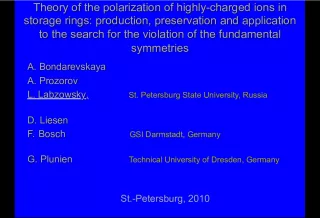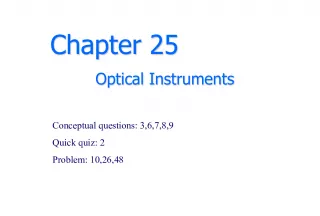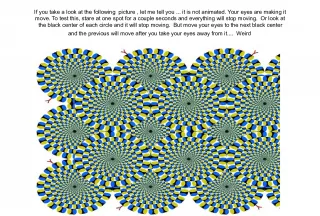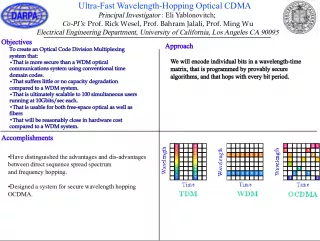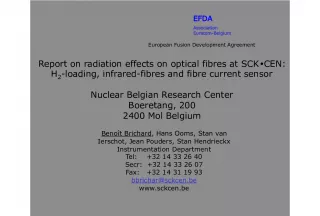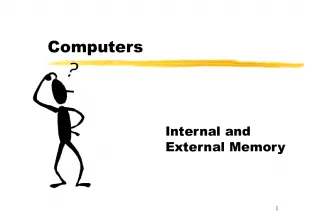Fluorescence Polarization and Optical Polarizers
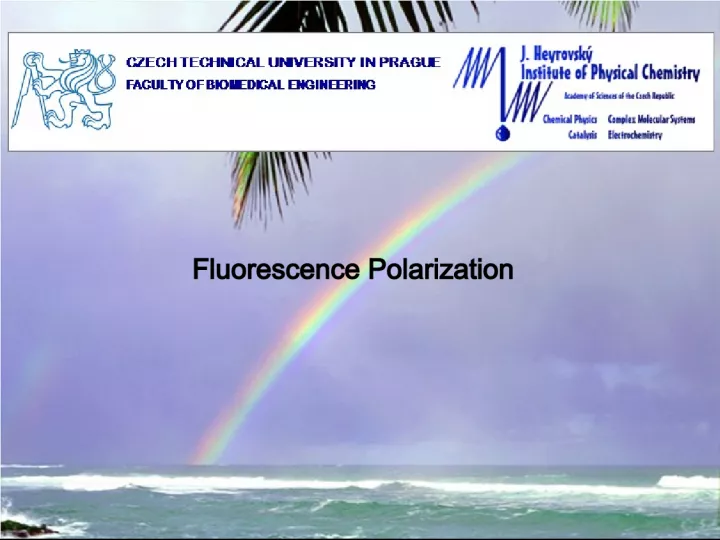

This article discusses the importance of polarization in light interaction with matter, including the types of optical polarizers commonly used to select specific polarizations. It also explores how fluorescence polarization can be used in biological and chemical applications.
- Uploaded on | 1 Views
-
 sigismund
sigismund
About Fluorescence Polarization and Optical Polarizers
PowerPoint presentation about 'Fluorescence Polarization and Optical Polarizers'. This presentation describes the topic on This article discusses the importance of polarization in light interaction with matter, including the types of optical polarizers commonly used to select specific polarizations. It also explores how fluorescence polarization can be used in biological and chemical applications.. The key topics included in this slideshow are Fluorescence polarization, Polarization of light, Optical polarizers, Double refracting birefringent calcite crystals, Polaroid type H sheets,. Download this presentation absolutely free.
Presentation Transcript
1. Fluorescence Polarization
2. Light is a harmonic electromagnetic wave. When considering its interaction with matter we can in most cases neglect the magnetic part. The plain in which the electric vector E oscillates defines the polarization of light . Natural light contains randomly all possible orientations of electric vector Light propagation direction Unpolarized (random) light Polarization E B
3. an optical component that selects from passing light only the component polarized in a given direction Unpolarized (random) light Common polarizers: double refracting (birefrigent) calcite (CaCO 3 ) crystals- which refract components of light polarized in two perpendicular planes under different angles filters, which effectively absorb one plane of polarization (e.g., Polaroid type-H sheets based on stretched polyvinyl alcohol impregnated with iodine) Polarizer Linear polarized light Polarizer I 0 I = I 0 /2
4. In 1920, F. Weigert discovered that the fluorescence from solutions of dyes was polarized. Specifically, he looked at solutions of fluorescein, eosin, rhodamine and other dyes and noted the effect of temperature and viscosity on the observed polarization. Wiegert discovered that polarization increased with the size of the dye molecule and the viscosity of the solvent, yet decreased as the temperature increased . He recognized that all of these considerations meant that fluorescenc e polarization increased as the mobility of the emitting species decreased .
5. Polarization and dipole transitions Absorption: The probability of a transition of a molecule between two energetic levels (for example S 0 S 1 ) is proportional to cos 2 , where is the angle between the dipole moment of the transition and the direction of polarization of the excitation light. Emission of a point dipole is polarized in the direction of the dipole potential dipole orientation probability of excitation Photoselection: The phenomenon of anisotropic distribution of orientation of molecules in excited state in the sample caused by the properties of excitation light. The emitted intensity is proportional to sin 2 , where is the angle between the dipole and the direction of propagation of the emitted light + -
6. The polarization state of fluorescence is described by: Polarization in a fluorescence experiment Z Y X excitation detection I I Polarization Anisotropy Anisotropy is preferred because it contains the total intensity I T
7. Polarization in a fluorescence experiment Z Y X excitation detection I I Why is the total intensity I T equal to I + 2 I ??? For the reason of symmetry the component polarized in the X direction and Y direction have the same intensity I , but in the given geometry we detect only the one polarized in X direction. Note: anistropy of a mixture of fluorophores f i fraction of i -th fluorophore
8. Polarization in a fluorescence experiment Z Y X excitation detection I I First we consider the simplest case a single fluorophore with a fixed position of its transition dipole moment D I cos 2 I sin 2 sin 2 Next we take an ensemble of molecules with random values of Averaging over : I 1/2 sin 2
9. Polarization in a fluorescence experiment Z Y X excitation detection I I Let us consider random orientation of dipole moments we have to average over D The probability density function of finding an excited molecule with a dipole under the angle : size of the cone for given photoselection
10. Polarization in a fluorescence experiment Z Y X excitation detection I I Let us consider random orientation of dipole moments we have to average over D r 0 = 0.4
11. Polarization in a fluorescence experiment Z Y X excitation detection I I The derivation was true for molecules with collinear transition dipole moments of absorption and emission , that is however not a general situation. Let us consider an angle between the two dipoles D a D e r 0 P 0 0 0.4 0.5 54.7 0 0 90 -0.2 -0.333
12. Polarization of 2-photon fluorescence Molecules can be excited by a simultaneous absorption of 2 photons. The molecule is excited by energy 2 h exc . The process is nonlinear probability of excitation is proportional to I exc 2 . The excitation probability is proportional to cos 4 different photoselection h exc h exc h em h em > h exc
13. Polarization of multiphoton fluorescence
14. Anisotropy and molecular motion So far we have considered frozen molecules. However, in reality the molecules are mobile and their rotation changes the orientation of the dipole . Changes in are reducing the anisotropy caused by photoselection . Where is the rotational correlation time (Debye rotational relaxation time) which is the time for a given orientation to rotate through an angle given by the arccos e -1 (68.42 o ). For a spherical molecule: viscosity D translational diffusion coefficient For a globular protein: partial specific volume h degree of hydration
15. Temporal decay of anisotropy The temporal decay of anisotropy due to molecular rotations can be investigated by time-resolved fluorescence spectroscopy (like fluorescence lifetimes TCSPC, frequency domain) It also influences the value of anisotropy measured by steady-state fluorescence spectroscopy: Perrin equation Perrin, F. 1926. Polarisation de la Lumiere de Fluorescence. Vie Moyene des Molecules Fluorescentes. J. Physique. 7:390-401.
16. A plot of 1/ P - 1/3 versus T/ predicts a straight line, the intercept and slope of which permit determination of P o and the molar volume (if the lifetime is known). Shown below is such a plot (termed a Perrin-Weber plot) for protoporphyrin IX associated with apohorseradish peroxidase - the viscosity of the solvent is varied by addition of sucrose. Perrin-Weber plot Perrin equation for a spherical molecule expressed in terms of P E1
17. The plane defined by the direction of excitation and detection ( XY ) is called horizontal (it is usually horizontal in the experiment). The measured intensities are identified by two indices describing the orientations of the excitation polarizer and analyzer (the polarizer in the detection channel). We have to account for different sensitivities S of detection of individual polarizations Measuremet of fluorescence anisotropy Z Y X vertical excitation detection I I I VV I VH I P A polarizer analyzer V vertical H horizontal I VV = S V I I V H = S H I
18. In the case of horizontal excitation (excitation light polarized in Y direction), the light polarized in Z and X direction, which we detect are both I !!! Determination of G factor Z Y X horizontal excitation detection I I H V I H H I P A polarizer analyzer V vertical H horizontal I H V = S V I I HH = S H I I
19. Magic angle If we place no analyzer in the detection pathway, we measure I + I . That is, however, not the total intensity I T = I + 2 I . The fluorescence intensity decays measured in that way may be, therefore, distorted due to anisotropy decay . We can either measure separately I and I and calculate I T . or we can measure with an analyzer oriented under an angle , for which I would contribute to the passing light with a double weight compared to I Magic angle I I Note: Even unpolarized excitation causes photoselection, because the light transversally polarized. In that case the maximal anisotropy (for collinear transition dipole moments) r 0 MAX = 0.2 .
20. Time-resolved fluorescence anisotropy E2 POPOP Note: Scattered light can cause higher anisotropy, because it is completely polarized ( r sc = 1). It is necessary to minimize scattering for accurate anisotropy measurement
21. Following either intrinsic protein fluorescence (if possible) or by labeling the protein with a suitable probe one would expect the polarization of the system to decrease upon dissociation of the dimer into monomers since the smaller monomers will rotate more rapidly than the dimers (during the excited state lifetime). F F F F F F Hence for a given probe lifetime the polarization (or anisotropy) of the monomer will be less than that of the dimer Polarization methods are ideally suited to study the aggregation state of proteins . Consider, for example, the case of a protein dimer - monomer equilibrium. F F Lower P Higher P
22. The polarization/anisotropy approach is also very useful to study protein-ligand interactions in general. The first application of fluorescence polarization to monitor the binding of small molecules to proteins was carried out by D. Laurence in 1952 using Gregorio Webers instrumentation in Cambridge. Specifically, Laurence studied the binding of numerous dyes, including fluorescein, eosin, acridine and others, to bovine serum albumin, and used the polarization data to estimate the binding constants. E3
23. A typical plot of polarization versus ligand/protein ratio is shown below: In this experiment, 1 micromolar mant-GTP S (a fluorescent, non-hydrolyzable GTP analog) was present and the concentration of the GTP-binding protein, dynamin, was varied by starting at high concentrations followed by dilution. The binding curve was fit to the anisotropy equation (in this case the yield of the fluorophore increased about 2 fold upon binding). A K d of 8.3 micromolar was found E3
24. Among the first commercial instruments designed to use a fluorescence polarization immunoassay for clinical diagnostic purposes was the Abbott TDx introduced in 1981. The basic principle of a polarization immunoassay is to: 1. Add a fluorescent analog of a target molecule e.g., a drug to a solution containing antibody to the target molecule FPIA Fluorescence Polarization ImmunoAssay E 4 2. Measure the fluorescence polarization, which corresponds to the fluorophore bound to the antibody 3. Add the appropriate biological fluid, e.g., blood, urine, etc., and measure the decrease in polarization as the target molecules in the sample fluid bind to the antibodies, displacing the fluorescent analogs.
25. High Polarization Antibody + Fluorophore-linked antigen Unlabeled antigen + Low Polarization E 4
